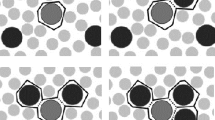Abstract
THERE are comparatively few cases of binary mixtures in which the activity or fugacity of one component has been interpreted in terms of molecular properties. Well-known instances of such treatments are the Debye–Hückel theory of electrolytes and Hildebrand's theory of regular solutions. We have examined the case of a binary mixture where interaction between the two components is negligible, but where one of the components (the solute) has a tendency to form multiplets of any degree of complexity by means of association, Since interaction is assumed to be negligible, the non-ideality of the solute is attributable entirely to association, and each multiplet species (including the monomer) may be supposed to constitute an ideal sub-system. We propose to call mixtures of this type 'perfect associating mixtures'.
Similar content being viewed by others
Author information
Authors and Affiliations
Rights and permissions
About this article
Cite this article
WARD, A., TORDAI, L. Activities of Associating Solutes. Nature 162, 494–495 (1948). https://doi.org/10.1038/162494b0
Issue Date:
DOI: https://doi.org/10.1038/162494b0
- Springer Nature Limited
This article is cited by
-
Micro-rheology of pigment dispersion by “ball-milling” in non-aqueous media
Kolloid-Zeitschrift (1960)
-
A study of adsorption and sedimentation in titania suspensions
Kolloid-Zeitschrift (1958)




